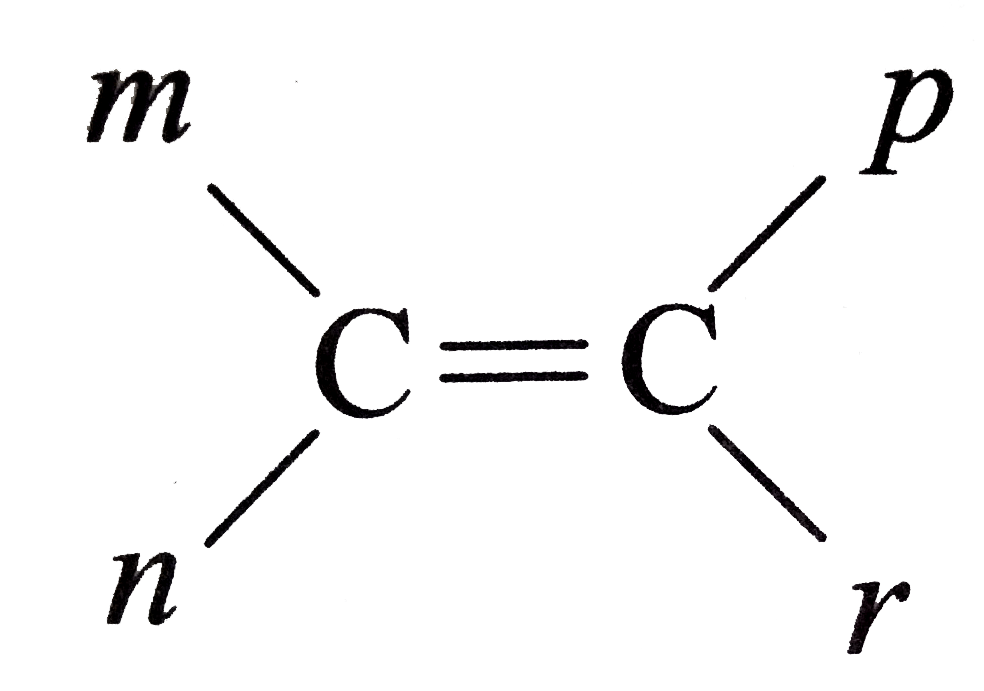While of the following compounds will exhibit geometrical (or cis-trans) isomerism?
(i) CH3CH=CHCH2CH3
(ii) C6H5CH=CHCH3
(iii) CH2=C(CH3)2
(CH3)2C=CH−C2H5
Strategy: Essential requirement for any alkene to exhibit geometrical isomerism is that each of the double bonded carbon atoms should be attached to two different atoms or groups of atoms:

m≠nandp≠r. Notice that m and p may be same or different Similarly, nandr may be same or different.
Structures (i) and (ii) will exhibit geometrical isomerism. Structures (iii) and (iv) fail to do so because two identical atosm and//or groups are attached to one of the doubly bonded carbon atoms.
Topper's Solved these Questions
Similar Questions
Knowledge Check
- Question 1 - Select One
Which of the following alkanes can exhibit cis-trans isomerism?
(i) CH2=CHCH2CH3 , (ii) CH2=C(CH3)2
(iii) CH3CH=CHCH3 , (iv) CH3CH2CH=CHClA(1) (i), (ii)B(2) (ii), (iii)C(3) (iii), (iv)D(4) (i), (iv) - Question 2 - Select One
In which of the following compounds corban atom undergoes hybridisation of more than one type
(i) CH3CH2CH2CH3
(ii) CH3−CH=CH−CH3
(iii) CH2=CH−CH2−CH3
(iv) H−C≡C−HA(iii) and (iv)B(i) and (iv)C(ii) and (iii)DOnly (ii) - Question 3 - Select One
Which of the following compounds have more than one type of hybridisation for carbon?
(i) HC≡CH
(ii) CH2=CH−C≡CH
(iii) CH3CH=CHCH3
(iv) CH3CH2CH2CH3A(iii)B(i)C(ii) and (iii)D(i) and (iii)
Which of the following compounds will show geometrical isomerism ?
(a) H2C=CBr2 (b)(H3)C)2C=CHCH3 (c)C6H5CH=CHCH3
(d) CH3CH2C∣CH3=CHCH2CH3 (e)H3C−CH=CCl(CH3)View SolutionClassify the following as alkyl, allyl and vinyl halides
(i) CH2CH=CFCH2CH3
(ii). (CH3)2CClCH3
(iii). CH2=CHCH2I
(iv). .View Solution
.View SolutionWhich of the following compounds have restricted rotation and out of which can show geometrical isomerism?
 (iii) CICH=CHCI (iv) Ph-N=N-Ph
(iii) CICH=CHCI (iv) Ph-N=N-Ph
(v) CH3CH=C(CH3)2 (vi) CH3CH=CH2 (vii) CH3CH=CHCH3 (viii) CH3−C≡C−CH3View SolutionArrange the following compounds in the increasing order of their boiling points:
CH3CH2CH2CHO,CH3CH2CH2CH2OH,H5C2−O−C2H5,CH3CH2CH2CH3View SolutionWhich of the following compounds have more than one type of hybridisation for carbon?
(i) HC≡CH
(ii) CH2=CH−C≡CH
(iii) CH3CH=CHCH3
(iv) CH3CH2CH2CH3View Solution

